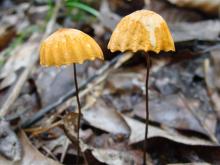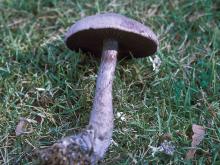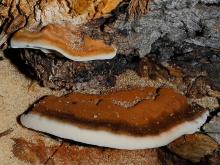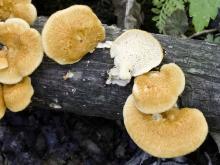Mushrooms
Media

Species Types
Scientific Name
Marasmius siccus
Description
The orange pinwheel marasmius is a tiny mushroom with an orange, bell-shaped, pleated cap, white gills, and a skinny brownish stalk. It grows scattered to many on dead leaves, wood, and twigs of deciduous trees.
Media

Species Types
Scientific Name
Cortinarius alboviolaceus
Description
The silvery-violet cort has a dry, grayish violet cap, pale violet gills, a club-shaped stalk, and a cobwebby partial veil. It's found in mixed woods, singly or in groups of many.
Media

Species Types
Scientific Name
Lactarius volemus
Description
The voluminous-latex milky has a velvety, orangish brown cap and stalk, white gills and flesh that exude a milky white latex, and a fishlike odor. It grows scattered in deciduous woods.
Species Types
Scientific Name
Amanita flavoconia
Description
The cap of this mushroom ranges from orange to yellow, with yellowish patches. The stalk has crumbling patches at the base, and a ring. It grows on the ground in mixed woods.
Media

Species Types
Scientific Name
Sarcoscypha occidentalis
Description
The stalked scarlet cup is, indeed, a tiny red cup on a tiny white stalk. It grows scattered on fallen wet sticks and branches in damp deciduous woods.
Media

Species Types
Scientific Name
Lycoperdon perlatum
Description
The gem-studded puffball is a white, rounded to turban-shaped ball, densely covered with spiny warts, developing a pore at the top. It grows on the ground in open woods, along roads, in waste areas.
Media

Species Types
Scientific Name
Ischnoderma resinosum
Description
The resinous polypore is a large, thick, velvety, brownish bracket fungus with a thick margin and whitish pores. It grows on logs and stumps of deciduous trees.
Media

Species Types
Scientific Name
Ganoderma sessile (formerly G. lucidum)
Description
The ling chih is a hard, usually flat, zoned bracket fungus with a reddish brown, shiny top. It grows at the base of living and dead deciduous trees, and also around stumps.
Media

Species Types
Scientific Name
Polyporus alveolaris (formerly Favolus alveolaris)
Description
This polypore is an orange to tan, fan-shaped bracket that is scaly on top; the underside has rows of white, six-sided, radially arranged pores. It grows singly or in groups on dead branches of deciduous trees.
Media

Species Types
Scientific Name
Phlebia incarnata (formerly Merulius incarnatus)
Description
The coral-pink merulius is a small, semicircular bracket fungus that is pinkish to coral to cream-colored, wrinkled, and veined beneath. It grows on dead logs and stumps of deciduous trees.
See Also



Media

Species Types
Scientific Name
Monotropa hypopitys
Description
Pinesap is a plant that puts the "wild" in wildflower! It lacks chlorophyll, so its roots connect to fungi underground and absorb nutrients from the fungi.
Media

Species Types
Scientific Name
Cladophora, Pithophora, and Spirogyra spp., and others
Description
Filamentous green algae forms green, cottony masses that are free-floating or attached to rocks, debris, or other plants.
Media

Species Types
Scientific Name
Monotropa uniflora
Description
Indian pipe lacks chlorophyll, so it is white, not green. Below ground, its roots join with fungi that connect to tree roots. This plant, then, takes nourishment indirectly from the trees.
About Mushrooms in Missouri
Mushrooms are a lot like plants, but they lack chlorophyll and have to take nutrients from other materials. Mushrooms are neither plants nor animals. They are in a different kingdom — the fungi. Fungi include the familiar mushroom-forming species, plus the yeasts, molds, smuts, and rusts.
Always be cautious when eating edible mushrooms. Be absolutely sure of the ID, and only eat a small amount the first time you try it to avoid a reaction..





















